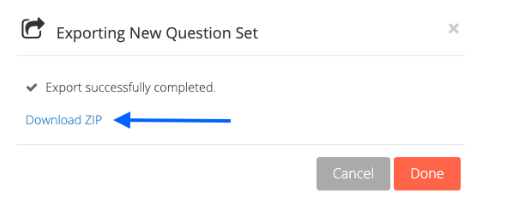Coventry University Group has two Inspera servers, or tenancies.
The test server is staff only and provides a sand-pit/development space. We recommend the test server is used for creating new Question Sets. The production server is solely for the delivery of tests to students and should not be used as a development space.
Once Question Sets have been created on the test server they can be easily transferred across to the production server. The Inspera export/import process is much simpler than Moodle.
Exporting Question Sets or Questions from Inspera as a QTI file
You can export your questions from the Test server using this guide from Inspera
Important: tick ‘Include namespaces from Inspera’

Downloading the export file
When exporting, the final step of downloading the ZIP folder is easily missed. Before clicking ‘Done’ at the end of the export process, there is a link to download the ZIP which needs to be clicked.

Importing QTI files into Inspera
import your questions to the Production Server using this guide.
It is also possible to import questions into Inspera using Excel files and if you have questions in Moodle then some question types can be copied across to Inspera. For details on how to use Excel files or move questions from Moodle see Importing questions into Inspera.
Mac users
Mac operating systems alter the ZIP folder when it is downloaded, by uncompressing it, and turning it back into a regular folder. This is incompatible with the Inspera Import process!
Users are faced with being asked to select a file from the folder when they try to import, and usually see a folder with numerous files which are greyed out on their screen.
To get past this, Mac users need to complete an additional step by opening the downloaded folder, selecting all the files inside the folder, and compressing them to form a new ZIP folder manually. Guidance on how to do this is available at Apple’s support site here
The newly created ZIP folder can be used in the Import process as normal.
Issue first reported April 2024. Appears to be part of the current operating system default settings.
